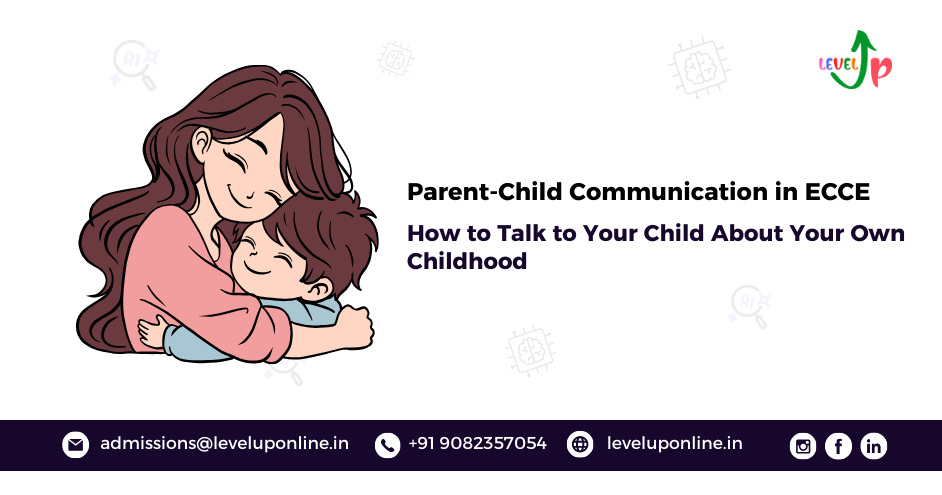Introduction
Do you remember the smell of your favorite childhood snack? Or the excitement of your first school trip? Children love hearing these stories—not just because they’re fun, but because they’re real. In Early Childhood Care and Education (ECCE), personal storytelling is one of the most underrated tools for building strong, genuine connections.
When parents and teachers open up about their own past, they give children a gift: a glimpse into a world where the grown-ups they know were once just like them—curious, playful, sometimes nervous, and always learning. These stories, when shared thoughtfully, can strengthen parent-child communication in ECCE, turning ordinary conversations into lessons that stick for life.
1. Why Your Childhood Stories Matter So Much
For young children, hearing about your life at their age is like opening a treasure chest. They discover:
1.1 You’ve been where they are now – You once worried about making friends, learned new skills, and made mistakes too.
1.2 Values in action – A real story about how you learned honesty or teamwork makes the lesson easier to understand.
1.3 A safe space for sharing – When you talk openly, they feel more comfortable opening up about their own experiences.
In parent-child communication in ECCE, stories aren’t just entertainment—they’re emotional bridges.
2. Choosing Stories That Stick
The best stories are the ones that feel close to their world. Pick memories that:
2.1 Match their age and understanding – Keep it light and relatable.
2.2 Tie into what they’re currently learning – A story about sharing during a lesson on friendship, for example.
2.3 End on a positive note – Even if the story starts with a challenge, show how it led to growth.
Example: If a child is frustrated about losing a game, share how you once lost a race but learned that trying your best mattered more than winning.
3. Paint Pictures with Your Words
Children remember details, not just facts. So, make your story feel alive:
3.1 Describe sounds, smells, and colors – “The smell of rain that day was so fresh, and my shoes made squishy sounds in the puddles.”
3.2 Act it out – Use facial expressions and hand gestures to pull them in.
This kind of vivid storytelling is what makes parent-child communication in ECCE magical.
4. The Perfect Moments to Share
A rushed moment rarely works for storytelling. Instead, choose times when they’re relaxed:
4.1 At home – Bedtime, lazy Sunday mornings, or cooking together.
4.2 In the classroom – Circle time, after an activity, or when a lesson links naturally to your memory.
Imagine: On a windy day, you say, “This reminds me of when I tried flying my first kite and it got stuck in a tree…” Suddenly, you have their full attention.
5. Turn Stories into Conversations
The magic happens when children start asking questions. Encourage it:
5.1 “What would you have done if you were me?”
5.2 “Has something like that happened to you?”
In parent-child communication in ECCE, curiosity is the spark that turns a story into a shared experience.
6. Teach Feelings Through Stories
Don’t just talk about what happened—talk about how you felt.
6.1 “I was scared to speak in front of the class, but I took a deep breath and tried anyway.”
6.2 “I felt sad when my friend moved away, but writing letters made me feel close to them again.”
This helps children name and understand their own emotions—a huge step in ECCE development.
7. Ditch the “Back in My Day” Tone
Comparing your childhood to theirs can make them feel disconnected. Instead of:
“We didn’t have all these gadgets when I was a kid,”
try:
“We used to make up our own games—what games do you play with your friends?”
In parent-child communication in ECCE, focus on curiosity and connection, not judgment.
8. Make Storytelling a Habit
The more often you share, the more natural it becomes:
8.1 Family tradition – One evening a week, tell a “memory story.”
8.2 Classroom ritual – Start Mondays with “A story from my childhood” linked to the week’s theme.
This consistency helps children see storytelling as a normal part of learning and connecting.
9. Share Your Roots and Traditions
Your childhood memories can carry your culture, heritage, and family values forward.
Example: “Every year before Diwali, my cousins and I would decorate our home with paper lanterns we made ourselves.”
In diverse ECCE settings, this helps children appreciate their own backgrounds and those of others.
10. When to Hold Back
Some stories aren’t right for young ears—especially those involving unresolved pain or heavy topics. If the lesson is valuable, keep it age-appropriate and focus on the positive outcome.
Emotional safety is a cornerstone of parent-child communication in ECCE.
11. Let Them Take the Storyteller’s Seat
After sharing your memory, invite them to tell one of their own:
11.1 “What’s your favorite memory so far?”
11.2 “Can you tell me about a time you felt proud?”
This not only strengthens trust but boosts their communication skills.
Conclusion
Sharing your childhood isn’t about reliving the past—it’s about shaping the present. In parent-child communication in ECCE, these stories make you relatable, trusted, and real in the eyes of a child.
Whether you’re tucking in your child at night or gathering a group of little learners in class, your memories can become gentle lessons in resilience, kindness, and curiosity. Tell them warmly, tell them honestly, and you’ll be giving children more than a story—you’ll be giving them a piece of your heart.


